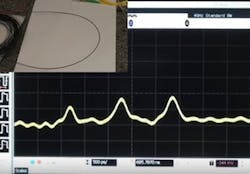Photoshop-like algorithms boost response of distributed optical fiber sensors (see video)
Optical specialty fibers containing fiber Bragg gratings or other sensing components allow the measurement of pressure, temperature, mechanical strain, acoustic signals, and other physical quantities at many places along these fibers as a function of time. But how to best handle the flood of spatial and temporal data from a sensing fiber up to 100 km long? Researchers at the Swiss Federal Institute of Technology (EPFL) Group for Fibre Optics (GFO; Lausanne, Switzerland) are now applying image-processing algorithms, similar to those used in Photoshop, to this problem.1 “We have no trouble getting a million measurement points from one optical fiber the width of a hair, for a resolution of one cm over 10 km,” says Luc Thévenaz, the director of GFO. Not only is this is 100 times more precise than current techniques, but the technique requires no hardware modifications.
Getting rid of parasites
Measurements made with distributed-sensing fibers have to be processed, because the measurement include noise in the form of so-called “parasites.” But the ratio between useful signals and noise cannot go below a certain threshold, otherwise the measurements will not be reliable. The EPFL researchers were able to boost this ratio significantly by borrowing a technology from graphic arts. “The values collected from these measurement points on the fiber can be represented as a matrix of pixels—a two-dimensional image,” says Thévenaz. "By applying standard graphic filters to this image, like those found in Photoshop, we were able to reduce the noise inherent in this measurement technique very effectively and identify the desired values more precisely.”
Pursuing this logic further, his teams also transformed more complex measurements, which take into account several parameters simultaneously, into video sequences. In this case, standard video-processing filters were used. These approaches are, by definition, less expensive than adding more measuring instruments. The performance-enhancement technique works because there is a high level of similarity and redundancy in the multidimensional information measured by distributed fiber sensors.
Source: http://actu.epfl.ch/news/photoshop-filters-for-safer-bridges/
REFERENCE:
1. Marcelo A. Soto et al., Nature Communications, 1 March 2016; doi:10.1038/ncomms10870 (Note: this paper was simultaneously published in Light: Science & Applications — Nature and Nature Communications)
About the Author
John Wallace
Senior Technical Editor (1998-2022)
John Wallace was with Laser Focus World for nearly 25 years, retiring in late June 2022. He obtained a bachelor's degree in mechanical engineering and physics at Rutgers University and a master's in optical engineering at the University of Rochester. Before becoming an editor, John worked as an engineer at RCA, Exxon, Eastman Kodak, and GCA Corporation.

